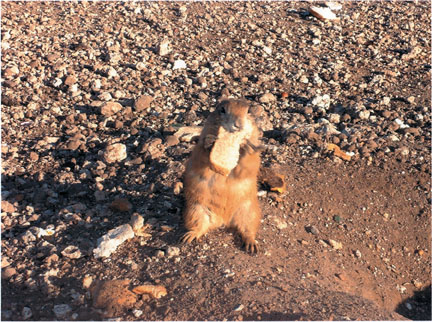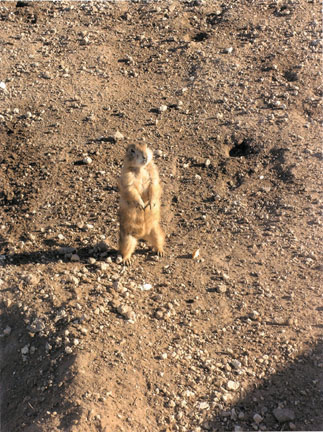|
 Prairie
dogs: endangered species or just plain pests? Government officials, farmers,
ranchers, and developers have asked this question, but it seems that no
one can agree on the answer. Prairie
dogs: endangered species or just plain pests? Government officials, farmers,
ranchers, and developers have asked this question, but it seems that no
one can agree on the answer.
Some background on the prairie dog seems to be in order. French explorers
called them "little dogs" because of the barking noise they
make. There are five species of prairie dogs found in North America. The
most abundant and widely distributed of these species is the black-tailed
prairie dog. The adult weighs between two and three pounds and can be
up to 17 inches long.
The black-tailed species is the prairie dog of the South Plains. Black-tailed
prairie dogs are not actually "dogs," but rather burrowing plant-eaters
that belong to the squirrel family. The black-tailed prairie dog is distinct
in its appearance and habitat because they are somewhat larger than the
other species and have a longer tail with a black tip.
The US Fish and Wildlife Service classify the black-tailed prairie dogs
as warranted but precluded. This status means that the USFWS has found
scientific data justifying a listing of this variety of prairie dogs as
threatened. The precluded part of the classification is important in that
the USFWS is claiming that other species in the region are more endangered.
It also means that the USFWS doesn’t have the resources available
to help the prairie dogs. The USFWS also faces great political opposition
to listing the prairie dog as threatened and NOT precluded by farmers,
ranchers, developers, and state government officials.
Some possible reasons why farmers and ranchers have a problem with listing
the prairie dog as threatened and NOT precluded include the belief of conflict between cattle and the prairie dogs for
forage and the belief that cattle and horses have a high risk of breaking
their legs because of the prairie dog mounds. Also, the myth of prairie
dogs spreading the plague is enough to make anyone unsure about keeping
this animal around.
include the belief of conflict between cattle and the prairie dogs for
forage and the belief that cattle and horses have a high risk of breaking
their legs because of the prairie dog mounds. Also, the myth of prairie
dogs spreading the plague is enough to make anyone unsure about keeping
this animal around.
According to some scientific evidence, prairie dogs and cattle have a
mutually beneficial relationship. Some studies have shown prairie dogs
improve the forage for cattle, and cattle grazing allow prairie dog colonies
to expand in mid-grass prairie. Both cattle and prairie dogs have demonstrated
a preference for grazing together, just as bison and prairie dogs have
historically preferred each other’s company.
As for the myth that prairie dogs spread the plague, they actually die
from it, not spread it. However, just as dogs and cats can be hosts to
fleas that might carry the disease, so can prairie dogs. The fleas that
carry the plague are brought into the prairie dog colonies by other animals.
Because of a low immunity to the plague, this disease can wipe out an
entire colony of prairie dogs within days.
Depending on a person’s viewpoint, the prairie dogs can be a friend
or a foe. These animals are very highly sociable and are even sold in
pet shops as exotic pets. The battle continues in Congress between ranchers
and farmers and the environmentalists on whether or not this animal is
a pest or a benefit. If an agreement is not reached, the prairie dog may
become extinct and there will be none left on the South Plains, or anywhere
else.
|
|
|